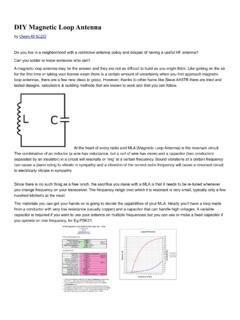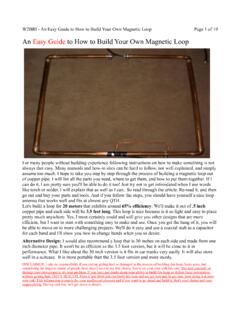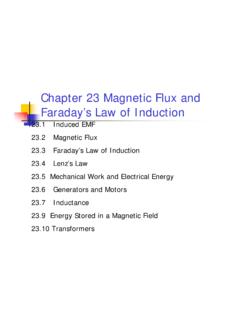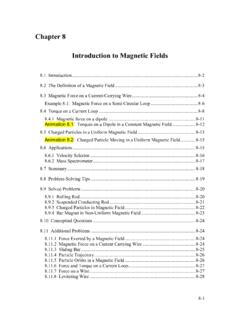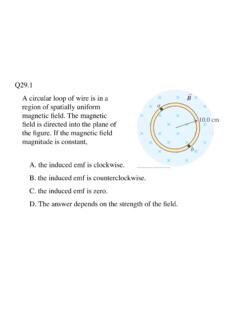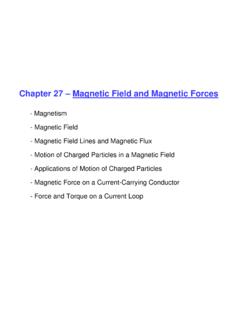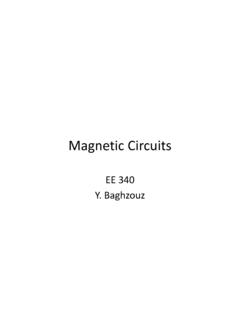Transcription of The Underestimated Magnetic Loop HF Antenna
1 1 An Overview of the Underestimated Magnetic Loop HF Antenna It seems one of the best kept secrets in the amateur radio community is how well a small diminutive Magnetic loop Antenna can really perform in practice compared with large traditional HF antennas. The objective of this article is to disseminate some practical information about successful homebrew loop construction and to enumerate the loop s key distinguishing characteristics and unique features.
2 A Magnetic loop Antenna (MLA) can very conveniently be accommodated on a table top, hidden in an attic / roof loft, an outdoor porch, patio balcony of a high-rise apartment, rooftop, or any other tight space constrained location. A small but efficacious HF Antenna for restricted space sites is the highly sort after Holy Grail of many an amateur radio enthusiast. This quest and interest is particularly strong from amateurs having to face the prospect of giving up their much loved hobby as they move from suburban residential lots into smaller restricted space retirement villages and other shared residential communities that have strict rules against erecting Antenna structures.
3 In spite of these imposed restrictions amateurs do have a practical and viable alternative means to actively continue the hobby using a covert in-door or portable outdoor and sympathetically placed low visual profile small Magnetic loop. This paper discusses how such diminutive antennas can provide an entirely workable compromise that enable keen amateurs to keep operating their HF station without any need for their previous tall towers and favourite beam antennas or unwieldy G5RV or long wire.
4 The practical difference in station signal strength at worst will be only an S-point or so if good MLA design and construction is adopted. Anyone making a cursory investigation into the subject of electrically-small antennas exemplified by the Magnetic loop Antenna using the Google internet search engine will readily find an overwhelming and perplexing abundance of material. This article will assist readers in making sense of the wide diversity of often times conflicting information with a view to facilitate the assimilation of the important essence of practical knowledge required to make an electrically-small loop work to its full potential and yield very good on-air performance with a capable account of itself vis- -vis time proven favourite HF antennas.
5 A few (sobering) facts A properly designed, constructed, and sited small MLA of nominal 1m diameter will equal and oftentimes outperform any Antenna type except a tri-band beam on the 10m/15m/20m bands, and will at worst be within an S-point (6 dB) or so of an optimised mono-band 3 element beam that s mounted at an appropriate height in wavelengths above ground. Magnetic loops really come into their own on the mid to higher HF bands from say 40m through to 10m; frequently exhibiting absolutely stunning performance rivalling the best conventional antennas.
6 Easily field deployable and fixed site tuned loops have been the routine Antenna of choice for many years in professional defence, military, diplomatic, and shipboard HF communication links where robust and reliable general coverage radio communication is deemed mandatory. On 80m and 160m top-band where the attainable (size constrained) efficiency is diminished the performance of a small loop Antenna still generally exceeds that achievable from a horizontal half-wave dipole, particularly one deployed at sub-optimal height above ground.
7 This is a very common site limitation for any HF Antenna on the lower bands. The real practical advantage of the small loop compared to say a short vertical whip tuned against earth or a full quarter-wave vertical Antenna is the loop s relative freedom from dependence on a ground plane and earth for achieving efficient operation; this unique characteristic has particular profound significance for realising small restricted space antennas operating on the lower 80m and 160m HF bands.
8 2 Comparing the efficiency of a short or full-sized vertical with a small loop Antenna one trades ground dependency and earth losses for much easier controllable conductor losses in both the loop radiating element and ohmic loss in the associated tuning capacitance and interconnections. A short whip or dipole is capacitive, and so needs inductance to be added to bring the Antenna to resonance. The converse is true for a small loop. It just happens to be true that high quality low loss capacitors are much easier to make than high quality low loss inductors.
9 Therefore a small loop resonated by a capacitor will have much higher Q than a short dipole resonated by an inductor. Having started from a better position, we then have more freedom to balance off bandwidth versus efficiency in design of the MLA. So where s the catch; if the small loop is such a good Antenna why doesn t everyone have one and dispense with their tall towers and traditional large antennas? The laws of nature and electromagnetics cannot be violated and the only unavoidable price one pays for operating with an electrically-small Antenna is narrow bandwidth.
10 Narrow instantaneous bandwidth rather than poor efficiency is the fundamental limiting factor trade-off with small loops . A small Antenna exhibits a compromise between bandwidth and efficiency whereby a small Antenna with high bandwidth always has low efficiency. The two parameters are inextricably linked, in that it is the same resistive losses that both broaden the bandwidth and reduce the efficiency. In some cases the loss resistance may be intrinsic to the Antenna structure; in other cases it may arise from coupling to its surroundings (which then means a lossy Antenna will not necessarily heat itself).



